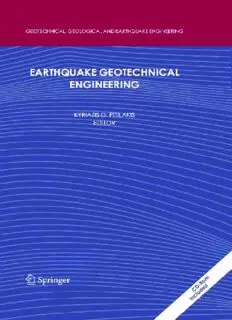Table Of ContentEARTHQUAKE GEOTECHNICAL ENGINEERING
GEOTECHNICAL, GEOLOGICAL AND EARTHQUAKE
ENGINEERING
Volume 6
Series Editor
Atilla Ansal, Kandilli Observatory and Earthquake Research Institute,
Boa(cid:247)ziçi University, Istanbul, Turkey
Editorial Advisory Board
Julian Bommer, Imperial College London, U.K.
Jonathan D. Bray, University of California, Berkeley, U.S.A.
Kyriazis Pitilakis, Aristotle University of Thessaloniki, Greece
Susumu Yasuda, Tokyo Denki University, J apan
The titles published in this series are listed at the end of this volume
EARTHQUAKE GEOTECHNICAL
ENGINEERING
4th International Conference on Earthquake
Geotechnical Engineering-Invited Lectures
edited by
KYRIAZIS D. PITILAKIS
Department of Civil Engineering,
AristotleUniversity of Thessaloniki, Greece
A C.I.P.Catalogue record for this book is available from the Library of Congress.
ISBN 978-1-4020-5892-9 (HB)
ISBN 978-1-4020-5893-6 (e-book)
Published by Springer,
P.O.Box 17, 3300 AADordrecht, The Netherlands.
www.springer.com
Printed on acid-free paper
All Rights Reserved
© 2007 Springer
No part of this work may be reproduced, stored in a retrieval system, or transmitted
in any form or by any means, electronic, mechanical, photocopying, microfilming,
recording or otherwise, without written permission from the Publisher, with the exception
of any material supplied specifically for the purpose of being entered
and executed on a computer system, for exclusive use by the purchaser of the work.
PREFACE
GeotechnicalEarthquakeEngineeringandSoilDynamics,aswellastheirinterfacewith
EngineeringSeismology,GeophysicsandSeismology,haveallmadeimportantprogress
overthepast15years,mainlyduetothedevelopmentofinstrumentedlargescaleexper-
imentalfacilities,totheincreaseinthequantityandqualityofrecordedearthquakedata,
to the numerous well-documented case studies from recent strong earthquakes as well
as enhanced computer capabilities. One of the major factors contributing to the afore-
mentioned progress is the increasing social need for a safe urban environment, large
infrastructuresandessentialfacilities.Theadvancesachievedarealsoconfirmedbythe
increasing number of scientific journals and publications which are relevant to thefield
ofGeotechnicalEarthquakeEngineering.
ThesuccessfulInternationalConferencesonGeotechnicalEarthquakeEngineeringorga-
nizedevery4yearsbytheTechnicalCommitteeofEarthquakeEngineeringoftheInter-
national Society of Soil Mechanics and Geotechnical Engineering constitute irrefutable
evidenceastothegrowinginteresttakenbythescientificandengineeringcommunityin
GeotechnicalEarthquakeEngineering.
This book contains the full papers of the invited keynote and theme lectures, including
the2ndIshiharalecture,givenduringthe4thInternationalConferenceonGeotechnical
Earthquake Engineering (4ICEGE) held in June 2006 in Thessaloniki, Greece. It pro-
vides a thorough presentation of state-of-the-art topics related to Earthquake Geotech-
nical Engineering and Soil Dynamics and their interface with Engineering Seismology,
Geophysics and Seismology. Interdisciplinary topics such as vulnerability assessment
andseismicriskmanagementofgeotechnicalstructuresandlifelinesarealsoaddressed
anddiscussed.Acomprehensiveoverviewofthepossibilitiesofferedbytherecentworld-
widedevelopmentsinlargescaletestingfacilitiesandstronggroundmotionarraysisalso
illustrated.
The nineteen chapters of this book, prepared by distinguished scientists and experts,
provide a panorama of recent achievements in Geotechnical Earthquake Engineering.
Certain unresolved engineering issues are also highlighted and some speculations and
ideasforthefuturearementioned.
Themainscopeofthebookistoprovidetheengineeringsociety,includinggeotechnical
andstructuralengineers,geologistsandseismologistsaswellasriskmanagingscientists,
withthemostrecentadvancesanddevelopmentsinthestudyofsoildynamics,earthquake
geotechnicalengineering,seismologyandriskassessmentandmanagement.
KyriazisPitilakis
ProfessorofAristotleUniversity,Chairmanof4ICEGE
Editor
v
TABLEOFCONTENTS
Preface ................................................................ v
Chapter 1. SPT- and CPT-based relationships for the Residual Shear
StrengthofLiquefiedSoils
I.M.IdrissandR.W.Boulanger
1. Introduction ........................................................ 1
2. Casehistorystudies.................................................. 3
3. SPT-basedcorrelationforresidualstrength .............................. 7
3.1. CorrelationofSrwith(N1)60cs-Sr ................................. 7
3.2. CorrelationofSr/σ(cid:1)vowith(N1)60cs-Sr ............................. 8
4. CPT-basedcorrelationforresidualstrength .............................. 12
4.1. ConvertingtheSPTCorrelation................................... 13
4.2. CPTValuesforCaseHistories.................................... 15
5. Concludingremarks ................................................. 17
References ......................................................... 21
Chapter 2. Long Period Strong Ground Motion and its Use as Input
toDisplacementBasedDesign
E.Faccioli,C.Cauzzi,R.Paolucci,M.Vanini,M.Villani,
andD.Finazzi
1. Introduction ........................................................ 23
2. Empirical prediction of displacement spectral response (DRS)
overabroadperiodrange ............................................. 24
2.1. DataSelection ................................................. 25
2.2. PredictionEquationsforDisplacementSpectralResponse............. 28
2.3. InfluenceofLocalGroundConditions.............................. 31
2.4. VerticalSpectra ................................................ 34
2.5. ASimplifiedSpectralDisplacementModel.......................... 35
2.6. OtherAspects.................................................. 36
vii
viii Tableofcontents
3. Responseofalluviumfilledvalleysandbasins ........................... 37
4. Overdampedspectra ................................................. 43
5. Hazardrepresentationsinspectraldisplacements ......................... 44
5.1. CriteriafortheHazardAnalysis .................................. 44
5.2. ExtentoftheLongPeriod,ConstantDisplacementRange ............. 45
5.3. Overdamped,UniformHazard(UH)DRS........................... 45
5.4. EffectsRelatedtoLocalSoilAmplification.......................... 46
5.5. SpectralDisplacementMaps ..................................... 47
References ......................................................... 49
Chapter3. SiteEffects:FromObservationandModellingtoAccounting
fortheminBuildingCodes
F.J.Cha´vez-Garc´ıa
1. Introduction ........................................................ 53
2. Estimationofsiteeffects.............................................. 55
3. Modellingsiteeffects.Theimportanceofthemodel....................... 61
4. Accountingforsiteeffectsinbuildingcodes ............................. 67
5. Concludingremarks ................................................. 69
References ......................................................... 70
Chapter4. SourceandSiteFactorsinMicrozonation
A.AnsalandG.To¨nu¨k
1. Introduction ........................................................ 73
2. Inputmotion........................................................ 74
2.1. RealAccelerationRecords ....................................... 74
2.2. SimulatedAccelerationRecord ................................... 76
3. Sitecharacterisation ................................................. 78
4. Microzonation ...................................................... 80
4.1. MicrozonationwithRespecttoGroundMotion ...................... 80
4.2. MicrozonationwithRespecttoLiquefactionSusceptibility............. 81
5. Spectralaccelerationsforvulnerabilityassessments ....................... 86
Tableofcontents ix
6. Conclusions ........................................................ 89
References ......................................................... 90
Chapter 5. A Review of Large-Scale Testing Facilities in Geotechnical
EarthquakeEngineering
A. Elgamal, K. Pitilakis, R. Dimitrios, J. Garnier, SP. Gopal
Madabhushi,A.Pinto,J.Steidl,H.E.Stewart,K.H.Stokoe,F.Taucer,
K.Tokimatsu,andJ.W.Wallace
1. Introduction ........................................................ 93
2. Instrumentedtestsites................................................ 95
2.1. EuroseisProject................................................ 95
2.1.1. Projectobjectives ......................................... 96
2.1.2. Generaldescriptionofthetestsite........................... 96
2.1.3. Instrumentation........................................... 99
2.1.4. Mainscientificandengineeringoutcomes..................... 101
2.2. UcsbNeesGarnerValleyandWildlifeTestSites
(Dr.JamiesonSteidl,PI)......................................... 102
2.2.1. SoilandseismiccharacteristicsatGarnerValley............... 102
2.2.2. Geologicconditions ....................................... 102
2.2.3. GarnerValleySFSIstructure ............................... 103
2.2.4. Wildliferefugeliquefactionfieldsite ......................... 104
3. Mobilelaboratories .................................................. 106
3.1. NeesFacilitiesatUCLA ......................................... 106
3.1.1. Eccentricmassshakers .................................... 106
3.1.2. Linearshaker ............................................ 107
3.1.3. Conepenetrationtestingtruck .............................. 107
3.1.4. Satellitesystem ........................................... 108
3.2. NEESFacilitiesattheUniversityofTexas .......................... 109
3.2.1. Cruiser(instrumentationvan)............................... 109
3.2.2. Thumper ................................................ 110
3.2.3. T-Rex(tri-axialvibrosies) .................................. 110
x Tableofcontents
3.2.4. Liquidator(lowfrequencyvibrosies) ......................... 110
3.2.5. Representativecollaborativeresearchproject.................. 111
4. Large-scaletestingfacilities........................................... 113
4.1. NEESFacilitiesatCornell ....................................... 113
4.2. UCSDShakeTable.............................................. 115
4.3. JapanE-DefenseShakeTable..................................... 116
4.3.1. RecentshakingtabletestsatE-Defense....................... 116
4.3.2. Representativetestresults .................................. 118
5. Earthquakeloadingaboardgeotechnicalcentrifuges....................... 118
5.1. DynamicCentrifugeModelling ................................... 119
5.2. ShakingFacilitiesatCambridgeUniversity ......................... 119
5.3. PneumaticShakeratCEA-CESTA,France.......................... 120
5.4. EarthquakeSimulationatLCPC,France ........................... 120
5.5. RecentAdvancesinEarthquakeActuationWorldwide ................ 121
6. Internationalcollaboration ............................................ 123
6.1. LargeTestingFacilitiesWorldwide ................................ 123
6.2. EuropeanExperienceonCollaboration ............................ 123
6.3. TheUSANEESInitiative ........................................ 125
6.4. InternationalCollaborationChallengesandOpportunities ............ 126
6.4.1. Simulation ............................................... 126
6.4.2. Cyberenvironments........................................ 127
6.4.3. Datainfrastructure........................................ 127
7. Summaryandconclusions ............................................ 127
References ......................................................... 127
Chapter6. ModellingofDynamicSoilProblems
D.M.Wood
1. Introduction ........................................................ 131
2. Constitutivemodellingframework...................................... 132
3. Fabric,soilstiffnessandlaboratorygeophysics ........................... 133

